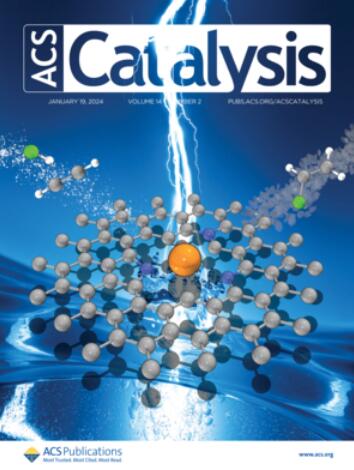Unveiling Dominant Active Sites in CD3OD Synthesis on Cu-Based Catalysts: Coverage-Dependent Microkinetic Modeling
IF 11.3
1区 化学
Q1 CHEMISTRY, PHYSICAL
引用次数: 0
Abstract
Deuterated methanol (CD3OD) is widely utilized as a deuterium source in nuclear magnetic resonance solvents and the development of deuterium-labeled pharmaceuticals. However, the predominant active sites and underlying reaction mechanisms governing the synthesis of CD3OD from CO and deuterium gas (D2) over Cu-based catalysts remain elusive. In this study, we develop a microkinetic model, incorporating adsorbate–adsorbate interactions based on first-principles calculations, to comprehensively elucidate the mechanism of CO deuteration. This coverage-dependent model highlights the crucial role of intermediate coverage effects, identifying Cu(110) as the dominant active site. At 513.15 K, the model predicts a turnover frequency (TOF) of 1.41 × 103 s–1, in good agreement with experimental data, whereas the coverage-independent model yields an unrealistically low TOF of 3.7 × 10–10 s–1. Furthermore, the coverage-dependent model successfully reproduces the volcano-shaped trend observed in catalytic activity and selectivity across the entire temperature range, addressing inconsistencies in conventional models. Our findings reveal that Cu(110) and Cu(211) surfaces, enriched with CO and CD3O species, significantly enhance CD3OD production. The CD3O intermediate is identified as the key surface species, with reaction pathways exhibiting substantial variation as a function of surface coverage.揭示铜基催化剂合成CD3OD的优势活性位点:覆盖依赖微动力学模型
氘化甲醇(CD3OD)作为氘源广泛应用于核磁共振溶剂和氘标记药物的开发。然而,控制CO和氘气(D2)在cu基催化剂上合成CD3OD的主要活性位点和潜在反应机制仍然是未知的。在本研究中,我们建立了一个基于第一性原理计算的微动力学模型,将吸附物-吸附物相互作用纳入其中,以全面阐明CO氘化的机理。这个依赖于覆盖的模型强调了中间覆盖效应的关键作用,确定了Cu(110)是主要的活性位点。在513.15 K时,该模型预测的周转率(TOF)为1.41 × 103 s-1,与实验数据吻合良好,而覆盖无关模型的TOF为3.7 × 10-10 s-1。此外,依赖于覆盖率的模型成功地再现了在整个温度范围内观察到的火山状催化活性和选择性趋势,解决了传统模型的不一致性。研究结果表明,Cu(110)和Cu(211)表面富集了CO和cd30,显著提高了CD3OD的生成。cd30中间体被确定为关键的表面物质,其反应途径随表面覆盖度的变化而发生实质性变化。
本文章由计算机程序翻译,如有差异,请以英文原文为准。
求助全文
约1分钟内获得全文
求助全文
来源期刊

ACS Catalysis
CHEMISTRY, PHYSICAL-
CiteScore
20.80
自引率
6.20%
发文量
1253
审稿时长
1.5 months
期刊介绍:
ACS Catalysis is an esteemed journal that publishes original research in the fields of heterogeneous catalysis, molecular catalysis, and biocatalysis. It offers broad coverage across diverse areas such as life sciences, organometallics and synthesis, photochemistry and electrochemistry, drug discovery and synthesis, materials science, environmental protection, polymer discovery and synthesis, and energy and fuels.
The scope of the journal is to showcase innovative work in various aspects of catalysis. This includes new reactions and novel synthetic approaches utilizing known catalysts, the discovery or modification of new catalysts, elucidation of catalytic mechanisms through cutting-edge investigations, practical enhancements of existing processes, as well as conceptual advances in the field. Contributions to ACS Catalysis can encompass both experimental and theoretical research focused on catalytic molecules, macromolecules, and materials that exhibit catalytic turnover.
 求助内容:
求助内容: 应助结果提醒方式:
应助结果提醒方式:


